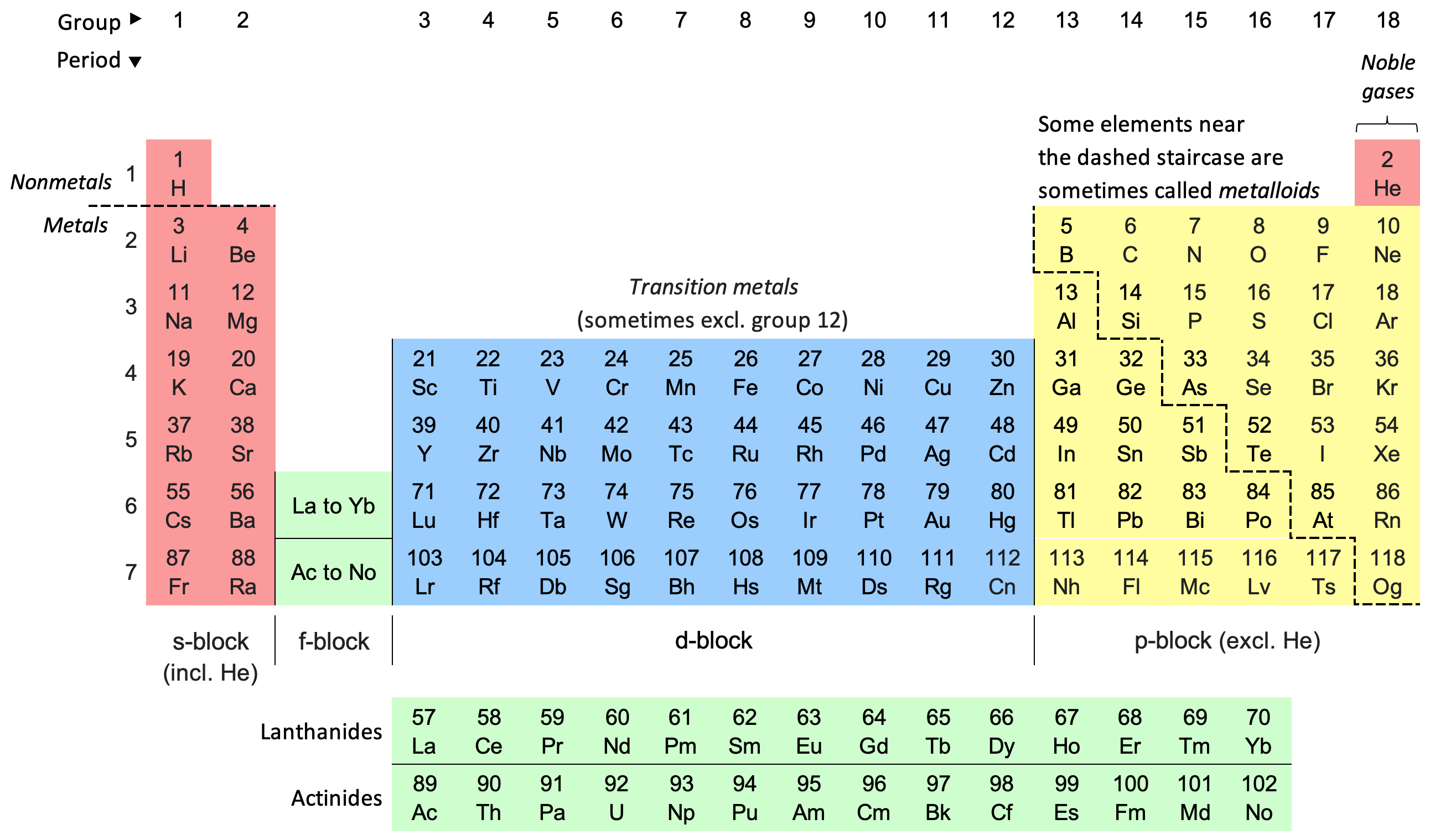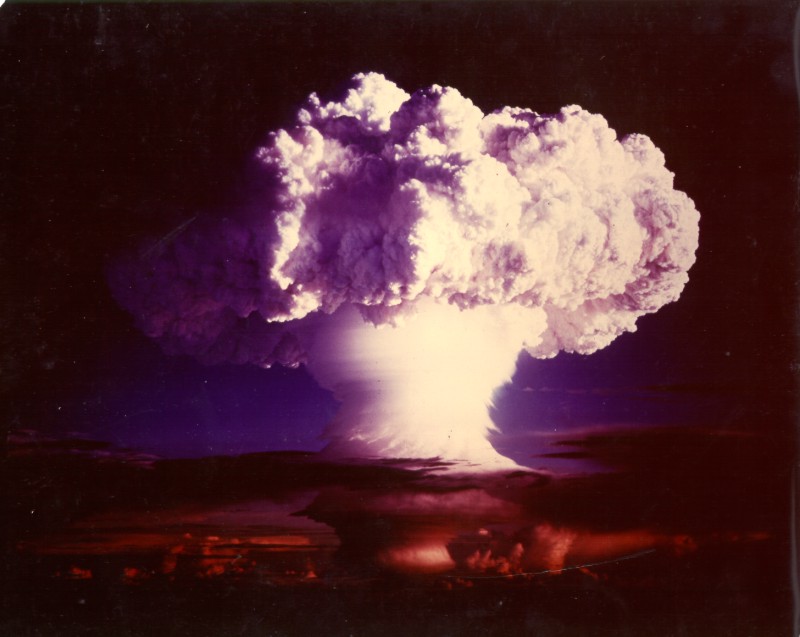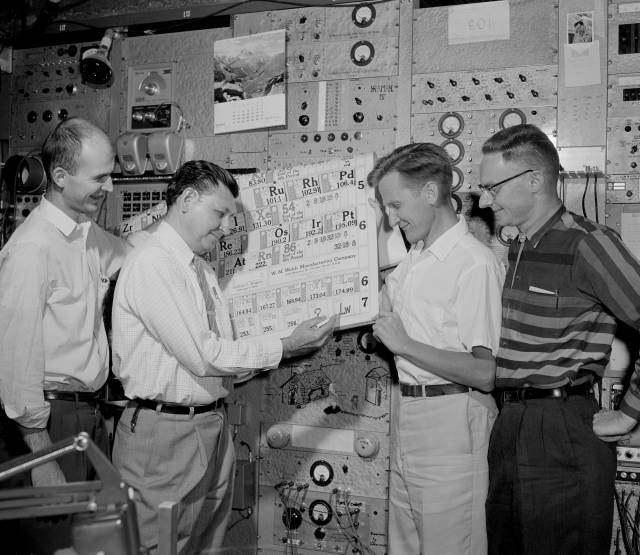|
Mendelevium
Mendelevium is a synthetic chemical element; it has symbol Md ( formerly Mv) and atomic number 101. A metallic radioactive transuranium element in the actinide series, it is the first element by atomic number that currently cannot be produced in macroscopic quantities by neutron bombardment of lighter elements. It is the third-to-last actinide and the ninth transuranic element and the first transfermium. It can only be produced in particle accelerators by bombarding lighter elements with charged particles. Seventeen isotopes are known; the most stable is 258Md with half-life 51.59 days; however, the shorter-lived 256Md (half-life 77.7 minutes) is most commonly used in chemistry because it can be produced on a larger scale. Mendelevium was discovered by bombarding einsteinium with alpha particles in 1955, the method still used to produce it today. It is named after Dmitri Mendeleev, the father of the periodic table. Using available microgram quantities of e ... [...More Info...] [...Related Items...] OR: [Wikipedia] [Google] [Baidu] |
Gregory Robert Choppin
Gregory Robert Choppin (November 9, 1927, Texas, United States – October 21, 2015, Tallahassee, Florida) was an American nuclear chemist and co-discoverer of the element mendelevium, atomic number 101. Others in the discovery group were Albert Ghiorso, Bernard G. Harvey, Stanley G. Thompson, and Glenn T. Seaborg. The element was named in honor of Dmitri Mendeleev. Choppin received a Bachelor of Science degree at Loyola University New Orleans and earned his doctorate at the University of Texas in 1953. He then worked as a postdoctoral researcher at the University of California, Berkeley, from 1953 to 1956. While at Berkeley he co-discovered mendelevium. Video documentation of the discovery was produced by the television station KQED (TV), KQED and can be viewed on YouTube with a new narration by Claude Lyneis. He taught at Florida State University from 1956 until 2001. He served there as Chair of the Department of Chemistry and Biochemistry and was named Robert O. Lawton Disting ... [...More Info...] [...Related Items...] OR: [Wikipedia] [Google] [Baidu] |
Actinide
The actinide () or actinoid () series encompasses at least the 14 metallic chemical elements in the 5f series, with atomic numbers from 89 to 102, actinium through nobelium. Number 103, lawrencium, is also generally included despite being part of the 6d transition series. The actinide series derives its name from the first element in the series, actinium. The informal chemical symbol An is used in general discussions of actinide chemistry to refer to any actinide. The 1985 IUPAC nomenclature of inorganic chemistry, IUPAC ''Red Book'' recommends that ''actinoid'' be used rather than ''actinide'', since the suffix ''-ide'' normally indicates a negative ion. However, owing to widespread current use, ''actinide'' is still allowed. Actinium through nobelium are f-block elements, while lawrencium is a d-block element and a transition metal. The series mostly corresponds to the filling of the 5f electron shell, although as isolated atoms in the ground state many have anomalous configu ... [...More Info...] [...Related Items...] OR: [Wikipedia] [Google] [Baidu] |
Synthetic Element
A synthetic element is a known chemical element that does not occur naturally on Earth: it has been created by human manipulation of fundamental particles in a nuclear reactor, a particle accelerator, or the explosion of an atomic bomb; thus, it is called "synthetic", "artificial", or "man-made". The synthetic elements are those with atomic numbers 95–118, as shown in purple on the accompanying periodic table: these 24 elements were first created between 1944 and 2010. The mechanism for the creation of a synthetic element is to force additional protons into the Atomic nucleus, nucleus of an element with an atomic number lower than 95. All known (see: Island of stability) synthetic elements are unstable, but they radioactive decay, decay at widely varying rates; the half-lives of their longest-lived isotopes range from microseconds to millions of years. Five more elements that were first created artificially are strictly speaking not ''synthetic'' because they were later found in ... [...More Info...] [...Related Items...] OR: [Wikipedia] [Google] [Baidu] |
Periodic Table
The periodic table, also known as the periodic table of the elements, is an ordered arrangement of the chemical elements into rows (" periods") and columns (" groups"). It is an icon of chemistry and is widely used in physics and other sciences. It is a depiction of the periodic law, which states that when the elements are arranged in order of their atomic numbers an approximate recurrence of their properties is evident. The table is divided into four roughly rectangular areas called blocks. Elements in the same group tend to show similar chemical characteristics. Vertical, horizontal and diagonal trends characterize the periodic table. Metallic character increases going down a group and from right to left across a period. Nonmetallic character increases going from the bottom left of the periodic table to the top right. The first periodic table to become generally accepted was that of the Russian chemist Dmitri Mendeleev in 1869; he formulated the periodic law as ... [...More Info...] [...Related Items...] OR: [Wikipedia] [Google] [Baidu] |
Isotopes Of Mendelevium
Mendelevium (101Md) is a synthetic element, and thus a standard atomic weight cannot be given. Like all artificial elements, it has no stable isotopes. The first isotope to be synthesized was 256Md (which was also the first isotope of any element produced one atom at a time) in 1955. There are 17 known radioisotopes, ranging in atomic mass from 244Md to 260Md, and 10 isomers. The longest-lived isotope is 258Md with a half-life of 51.3 days, and the longest-lived isomer is 258mMd with a half-life of 57 minutes. List of isotopes , -id=Mendelevium-244 , rowspan=2, 244Md , rowspan=2 style="text-align:right" , 101 , rowspan=2 style="text-align:right" , 143 , rowspan=2, 244.08116(40)# , rowspan=2, [] , alpha decay, α , 240Es , rowspan=2, 3+# , - , beta decay, β+, spontaneous fission, SF (<14%) , (various) , -id=Mendelevium-244m , style="text-indent:1em" , 244mMd , colspan="3" style="text-indent:2em" , 200(150)# keV , ... [...More Info...] [...Related Items...] OR: [Wikipedia] [Google] [Baidu] |
Einsteinium
Einsteinium is a synthetic chemical element; it has symbol Es and atomic number 99 and is a member of the actinide series and the seventh transuranium element. Einsteinium was discovered as a component of the debris of the first hydrogen bomb explosion in 1952. Its most common isotope, einsteinium-253 (Es; half-life 20.47 days), is produced artificially from decay of californium-253 in a few dedicated high-power nuclear reactors with a total yield on the order of one milligram per year. The reactor synthesis is followed by a complex process of separating einsteinium-253 from other actinides and products of their decay. Other isotopes are synthesized in various laboratories, but in much smaller amounts, by bombarding heavy actinide elements with light ions. Due to the small amounts of einsteinium produced and the short half-life of its most common isotope, there are no practical applications for it except basic scientific research. In particular, einsteinium was used to synthesiz ... [...More Info...] [...Related Items...] OR: [Wikipedia] [Google] [Baidu] |
Transuranic Element
The transuranium (or transuranic) elements are the chemical elements with atomic number greater than 92, which is the atomic number of uranium. All of them are radioactively unstable and decay into other elements. Except for neptunium and plutonium, which have been found in trace amounts in nature, none occur naturally on Earth and they are synthetic. Overview Of the elements with atomic numbers 1 to 92, most can be found in nature, having stable isotopes (such as oxygen) or very long-lived radioisotopes (such as uranium), or existing as common decay products of the decay of uranium and thorium (such as radon). The exceptions are technetium, promethium, astatine, and francium; all four occur in nature, but only in very minor branches of the uranium and thorium decay chains, and thus all save francium were first discovered by synthesis in the laboratory rather than in nature. All elements with higher atomic numbers have been first discovered in the laboratory, with neptunium an ... [...More Info...] [...Related Items...] OR: [Wikipedia] [Google] [Baidu] |
Albert Ghiorso
Albert Ghiorso (July 15, 1915 – December 26, 2010) was an American nuclear scientist and co-discoverer of a record 12 chemical elements on the periodic table. His research career spanned six decades, from the early 1940s to the late 1990s. Biography Early life Ghiorso was born in Vallejo, California on July 15, 1915, of Italian and Spanish ancestry. He grew up in Alameda, California. Living near the Oakland International Airport, he became interested in airplanes, aeronautics, and other technologies. After graduating from high school, he built radio circuitry and earned a reputation for establishing radio contacts at distances that outdid the military. He received his Bachelor of Science, BS in electrical engineering from the University of California, Berkeley in 1937. After graduation, he worked for Reginald Tibbets, a prominent amateur radio operator who operated a business supplying radiation detectors to the government. Ghiorso's ability to develop and produce these instrum ... [...More Info...] [...Related Items...] OR: [Wikipedia] [Google] [Baidu] |
Chemical Symbol
Chemical symbols are the abbreviations used in chemistry, mainly for chemical elements; but also for functional groups, chemical compounds, and other entities. Element symbols for chemical elements, also known as atomic symbols, normally consist of one or two letters from the Latin alphabet and are written with the first letter capitalised. History Earlier symbols for chemical elements stem from classical Latin and Greek language, Greek words. For some elements, this is because the material was known in ancient times, while for others, the name is a more recent invention. For example, Pb is the symbol for lead (''plumbum'' in Latin); Hg is the symbol for mercury (element), mercury (''hydrargyrum'' in Greek); and He is the symbol for helium (a Neo-Latin name) because helium was not known in ancient Roman times. Some symbols come from other sources, like W for tungsten (''Wolfram'' in German) which was not known in Roman times. A three-letter Systematic element name, temporary sym ... [...More Info...] [...Related Items...] OR: [Wikipedia] [Google] [Baidu] |
Discovery Of The Chemical Elements
The discoveries of the 118 chemical elements known to exist as of 2025 are presented here in chronological order. The elements are listed generally in the order in which each was first defined as the pure element, as the exact date of discovery of most elements cannot be accurately determined. There are plans to synthesize more elements, and it is not known how many elements are possible. Each element's list of elements by name, name, atomic number, year of first report, name of the discoverer, and notes related to the discovery are listed. Periodic table of elements Graphical timeline ImageSize = width:1600 height:120 # barincrement:0 PlotArea = top:70 bottom:30 right:10 left:10 AlignBars = justify Colors = id:gray1 value:gray(0.85) legend:Independent id:gray2 value:gray(0.95) DateFormat = yyyy Period = from:1665 till:2025 TimeAxis = orientation:horizontal ScaleMajor = unit:year increment:10 start:1670 ScaleMinor = unit:year increment:1 start:1665 TextData = tex ... [...More Info...] [...Related Items...] OR: [Wikipedia] [Google] [Baidu] |
Light Element
A chemical element is a chemical substance whose atoms all have the same number of protons. The number of protons is called the atomic number of that element. For example, oxygen has an atomic number of 8: each oxygen atom has 8 protons in its atomic nucleus, nucleus. Atoms of the same element can have different numbers of neutrons in their nuclei, known as isotopes of the element. Two or more atoms can combine to form molecules. Some elements form Homonuclear molecule, molecules of atoms of said element only: e.g. atoms of hydrogen (H) form Diatomic molecule, diatomic molecules (H). Chemical compounds are substances made of atoms of different elements; they can have molecular or non-molecular structure. Mixtures are materials containing different chemical substances; that means (in case of molecular substances) that they contain different types of molecules. Atoms of one element can be transformed into atoms of a different element in nuclear reactions, which change an atom's at ... [...More Info...] [...Related Items...] OR: [Wikipedia] [Google] [Baidu] |







